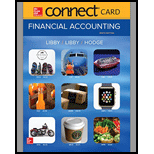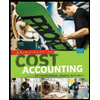
Connect Access Card for Financial Accounting
9th Edition
ISBN: 9781259738678
Author: Robert Libby, Patricia Libby, Frank Hodge Ch
Publisher: McGraw-Hill Education
expand_more
expand_more
format_list_bulleted
Concept explainers
Textbook Question
Chapter 7, Problem 7.6ME
Matching Inventory Costing Method Choices to Company Circumstances
LO7-3 Indicate whether the FIFO or LIFO inventory costing method would normally be selected when inventory costs are rising. Explain why.
Expert Solution & Answer
Want to see the full answer?
Check out a sample textbook solution
Students have asked these similar questions
1) Identify whethere the company is paying out dividends based on the attached statement.
2) Describe in detail how that the company’s dividend payouts have changed over the past five years.
3)Describe in detail the changes in “total equity” (representing the current “book value” of the company).
Which is not an objective of internal controls?A. Safeguard assetsB. Improve profitsC. Ensure accurate recordsD. Promote operational efficiencyneed help
Which is not an objective of internal controls?A. Safeguard assetsB. Improve profitsC. Ensure accurate recordsD. Promote operational efficiencyno ai
Chapter 7 Solutions
Connect Access Card for Financial Accounting
Ch. 7 - Why is inventory an important item to both...Ch. 7 - Prob. 2QCh. 7 - Prob. 3QCh. 7 - Prob. 4QCh. 7 - Prob. 5QCh. 7 - The chapter discussed tour inventory costing...Ch. 7 - Prob. 7QCh. 7 - Contrast the effects of LIFO versus FIFO on...Ch. 7 - Contrast the income statement effect of LIFO...Ch. 7 - Prob. 10Q
Ch. 7 - Explain briefly the application of the LCM concept...Ch. 7 - Prob. 12QCh. 7 - Consider the following information: ending...Ch. 7 - The inventory costing method selected by a company...Ch. 7 - Which of the following is not a component of the...Ch. 7 - Consider the following information: beginning...Ch. 7 - Consider the following information: beginning...Ch. 7 - An increasing inventory turnover ratio a....Ch. 7 - If the ending balance in accounts payable...Ch. 7 - Which of the following regarding the lower of cost...Ch. 7 - Which inventory method provides a better matching...Ch. 7 - Which of the following is false regarding a...Ch. 7 - Prob. 7.1MECh. 7 - Recording the Cost of Purchases for a Merchandiser...Ch. 7 - Identifying the Cost of Inventories for a...Ch. 7 - Inferring Purchases Using the Cost of Goods Sold...Ch. 7 - Prob. 7.5MECh. 7 - Matching Inventory Costing Method Choices to...Ch. 7 - Reporting Inventory under Lower of Cost or Market...Ch. 7 - Determining the Effects of Inventory Management...Ch. 7 - Prob. 7.9MECh. 7 - Prob. 7.1ECh. 7 - Inferring Missing Amounts Based on Income...Ch. 7 - Prob. 7.3ECh. 7 - Inferring Merchandise Purchases Abercrombie and...Ch. 7 - Calculating Ending Inventory and Cost of Goods...Ch. 7 - Calculating Ending Inventory and Cost of Goods...Ch. 7 - Analyzing and Interpreting the Financial Statement...Ch. 7 - Analyzing and Interpreting the Financial Statement...Ch. 7 - Evaluating the Choice among Three Alternative...Ch. 7 - Evaluating the Choice among Three Alternative...Ch. 7 - Prob. 7.11ECh. 7 - Reporting Inventory at Lower of Cost or Market...Ch. 7 - Prob. 7.13ECh. 7 - Prob. 7.14ECh. 7 - Prob. 7.15ECh. 7 - Prob. 7.16ECh. 7 - Prob. 7.17ECh. 7 - Prob. 7.18ECh. 7 - Prob. 7.19ECh. 7 - Prob. 7.20ECh. 7 - (Chapter Supplement A) Analyzing the Effects of a...Ch. 7 - (Chapter Supplement B) FIFO and LIFO Cost of Goods...Ch. 7 - (Chapter Supplement C) Recording Sales and...Ch. 7 - Analyzing Items to Be Included in Inventory Travis...Ch. 7 - Prob. 7.2PCh. 7 - Evaluating Four Alternative Inventory Methods...Ch. 7 - Prob. 7.4PCh. 7 - Evaluating the LIFO and FIFO Choice When Costs Are...Ch. 7 - Evaluating the Income Statement and Cash Flow...Ch. 7 - Evaluating the Effects of Manufacturing Changes on...Ch. 7 - Evaluating the Choice between LIFO and FIFO Based...Ch. 7 - Prob. 7.9PCh. 7 - (Chapter Supplement A) Analyzing LIFO and FIFO...Ch. 7 - Prob. 7.1APCh. 7 - Evaluating Four Alternative Inventory Methods...Ch. 7 - Evaluating the UFO and FIFO Choice When Costs Are...Ch. 7 - Prob. 7.4APCh. 7 - Prob. 7.1CONCh. 7 - Finding Financial Information Refer to the...Ch. 7 - Finding Financial Information Refer to the...Ch. 7 - Comparing Companies within an Industry Refer to...Ch. 7 - Prob. 7.4CPCh. 7 - Using Financial Reports: Interpreting Effects of...Ch. 7 - Making a Decision as a Financial Analyst: Analysis...Ch. 7 - Evaluating an Ethical Dilemma: Earnings, Inventory...
Knowledge Booster
Learn more about
Need a deep-dive on the concept behind this application? Look no further. Learn more about this topic, accounting and related others by exploring similar questions and additional content below.Similar questions
- Can you solve this general accounting problem using appropriate accounting principles?arrow_forwardWhich is not an objective of internal controls?A. Safeguard assetsB. Improve profitsC. Ensure accurate recordsD. Promote operational efficiency no aiarrow_forwardPlease provide the accurate answer to this financial accounting problem using appropriate methods.arrow_forward
- Please provide the correct answer to this financial accounting problem using valid calculations.arrow_forward20 Nelson and Murdock, a law firm, sells $8,000,000 of four-year, 8% bonds priced to yield 6.6%. The bonds are dated January 1, 2026, but due to some regulatory hurdles are not issued until March 1, 2026. Interest is payable on January 1 and July 1 each year. The bonds sell for $8,388,175 plus accrued interest. In mid-June, Nelson and Murdock earns an unusually large fee of $11,000,000 for one of its cases. They use part of the proceeds to buy back the bonds in the open market on July 1, 2026 after the interest payment has been made. Nelson and Murdock pays a total of $8,456,234 to reacquire the bonds and retires them. Required1. The issuance of the bonds—assume that Nelson and Murdock has adopted a policy of crediting interest expense for the accrued interest on the date of sale.2. Payment of interest and related amortization on July 1, 2026.3. Reacquisition and retirement of the bonds.arrow_forward13 Which of the following is correct about the difference between basic earnings per share (EPS) and diluted earnings per share? Question 13 options: Basic EPS uses comprehensive income in its calculation, whereas diluted EPS does not. Basic EPS is not a required disclosure, whereas diluted EPS is required disclosure. Basic EPS uses total common shares outstanding, whereas diluted EPS uses the weighted-average number of common shares. Basic EPS is not adjusted for the potential dilutive effects of complex financial structures, whereas diluted EPS is adjusted.arrow_forward
arrow_back_ios
SEE MORE QUESTIONS
arrow_forward_ios
Recommended textbooks for you
 Intermediate Accounting: Reporting And AnalysisAccountingISBN:9781337788281Author:James M. Wahlen, Jefferson P. Jones, Donald PagachPublisher:Cengage Learning
Intermediate Accounting: Reporting And AnalysisAccountingISBN:9781337788281Author:James M. Wahlen, Jefferson P. Jones, Donald PagachPublisher:Cengage Learning Principles of Cost AccountingAccountingISBN:9781305087408Author:Edward J. Vanderbeck, Maria R. MitchellPublisher:Cengage LearningPrinciples of Accounting Volume 1AccountingISBN:9781947172685Author:OpenStaxPublisher:OpenStax College
Principles of Cost AccountingAccountingISBN:9781305087408Author:Edward J. Vanderbeck, Maria R. MitchellPublisher:Cengage LearningPrinciples of Accounting Volume 1AccountingISBN:9781947172685Author:OpenStaxPublisher:OpenStax College Financial Accounting: The Impact on Decision Make...AccountingISBN:9781305654174Author:Gary A. Porter, Curtis L. NortonPublisher:Cengage Learning
Financial Accounting: The Impact on Decision Make...AccountingISBN:9781305654174Author:Gary A. Porter, Curtis L. NortonPublisher:Cengage Learning Cornerstones of Financial AccountingAccountingISBN:9781337690881Author:Jay Rich, Jeff JonesPublisher:Cengage Learning
Cornerstones of Financial AccountingAccountingISBN:9781337690881Author:Jay Rich, Jeff JonesPublisher:Cengage Learning Financial Reporting, Financial Statement Analysis...FinanceISBN:9781285190907Author:James M. Wahlen, Stephen P. Baginski, Mark BradshawPublisher:Cengage Learning
Financial Reporting, Financial Statement Analysis...FinanceISBN:9781285190907Author:James M. Wahlen, Stephen P. Baginski, Mark BradshawPublisher:Cengage Learning

Intermediate Accounting: Reporting And Analysis
Accounting
ISBN:9781337788281
Author:James M. Wahlen, Jefferson P. Jones, Donald Pagach
Publisher:Cengage Learning

Principles of Cost Accounting
Accounting
ISBN:9781305087408
Author:Edward J. Vanderbeck, Maria R. Mitchell
Publisher:Cengage Learning

Principles of Accounting Volume 1
Accounting
ISBN:9781947172685
Author:OpenStax
Publisher:OpenStax College

Financial Accounting: The Impact on Decision Make...
Accounting
ISBN:9781305654174
Author:Gary A. Porter, Curtis L. Norton
Publisher:Cengage Learning

Cornerstones of Financial Accounting
Accounting
ISBN:9781337690881
Author:Jay Rich, Jeff Jones
Publisher:Cengage Learning

Financial Reporting, Financial Statement Analysis...
Finance
ISBN:9781285190907
Author:James M. Wahlen, Stephen P. Baginski, Mark Bradshaw
Publisher:Cengage Learning
Chapter 6 Merchandise Inventory; Author: Vicki Stewart;https://www.youtube.com/watch?v=DnrcQLD2yKU;License: Standard YouTube License, CC-BY
Accounting for Merchandising Operations Recording Purchases of Merchandise; Author: Socrat Ghadban;https://www.youtube.com/watch?v=iQp5UoYpG20;License: Standard Youtube License